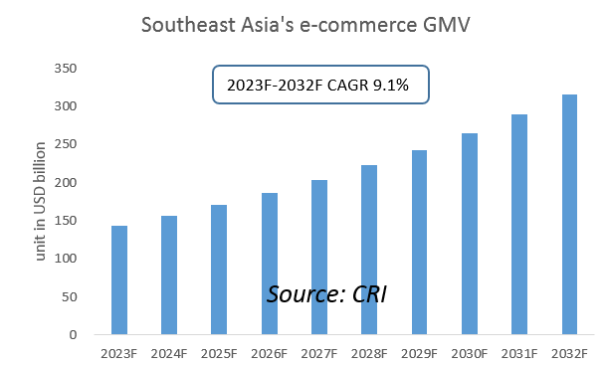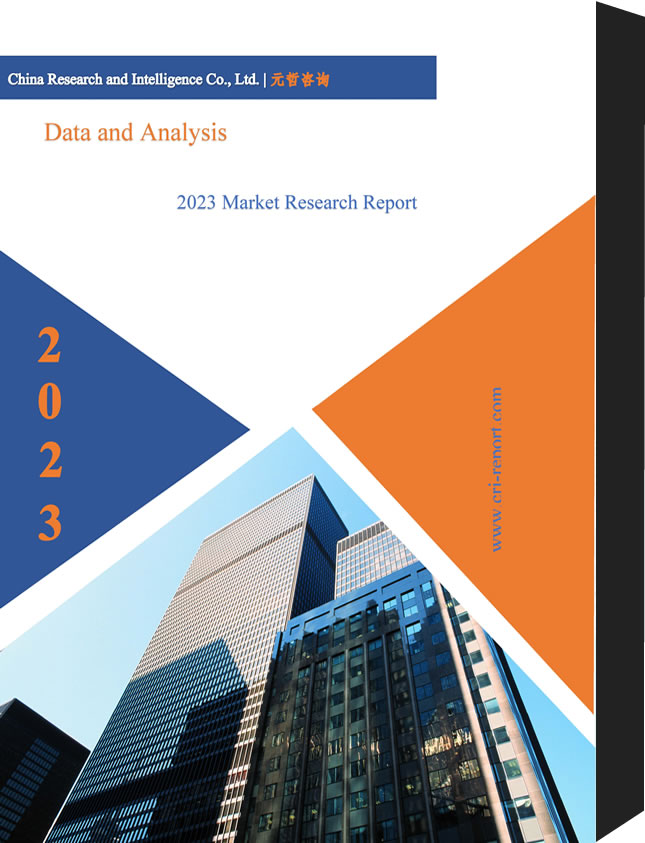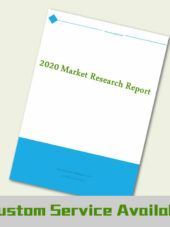Description
Southeast Asia E-Commerce Industry
Southeast Asia is the emerging market with the fastest economic growth and greatest development potential in the world. With the increase in per capita disposable income of Southeast Asian residents, the increase in mobile Internet penetration and the gradual shift in consumption habits, the e-commerce industry in Southeast Asia has gradually developed. According to a third-party study, the GMV of e-commerce will jump from US$10.9 billion to US$131 billion from 2017-2022, with a compound annual growth rate of 64%.

There are differences in the development of e-commerce industry among Southeast Asian countries. According to CRI’s analysis, Singapore has a well-developed e-commerce industry, and the largest online e-commerce platforms in Southeast Asia, Shopee and Lazada, are both headquartered in Singapore; Malaysia has a high Internet penetration rate and a mature e-commerce market; Indonesia has a population of more than 274 million, and its huge population makes Indonesia have the largest e-commerce market in Southeast Asia. The e-commerce industry in the Philippines, Vietnam and Thailand are in the growth explosion period, developing rapidly and with great potential.
Southeast Asia in this report includes 10 countries: Singapore, Thailand, Philippines, Malaysia, Indonesia, Vietnam, Myanmar, Brunei, Laos and Cambodia. With a total population of over 600 million by the end of 2021, Southeast Asia has an overall economic growth rate higher than the global average and is one of the key drivers of future global economic growth.
According to CRI’s analysis, the economic levels of the 10 Southeast Asian countries vary greatly, with Singapore being the only developed country with a per capita GDP of about US$73,000 in 2021. While Myanmar and Cambodia will have a GDP per capita of less than US$2,000 in 2021. The population and minimum wage levels of each country also vary greatly. Brunei, which has the smallest population, will have a total population of less than 500,000 people in 2021, while Indonesia, which has the largest population, will have a population of about 275 million people in 2021.
CRI expects the Southeast Asia e-commerce industry to maintain growth from 2023-2032. On the one hand, the number of online shopping users in Southeast Asia has been increasing year after year, showing a trend of rejuvenation and huge potential for consumption growth. On the other hand, Southeast Asia’s digital financial services, such as online payment and microfinance, continue to develop, driving the scale of Southeast Asia’s e-commerce industry to continue to expand.
Topics covered:
- Southeast Asia E-Commerce Industry Status and Major Sources in 2018-2022
- What is the Impact of COVID-19 on Southeast Asia E-Commerce Industry?
- Which Companies are the Major Players in Southeast Asia E-Commerce Industry Market and What are their Competitive Benchmarks?
- Key Drivers and Market Opportunities in Southeast Asia E-Commerce Industry
- What are the Key Drivers, Challenges, and Opportunities for Southeast Asia E-Commerce Industry during 2023-2032?
- What is the Expected Revenue of Southeast Asia E-Commerce Industry during 2023-2032?
- What are the Strategies Adopted by the Key Players in the Market to Increase Their Market Share in the Industry?
- What are the Competitive Advantages of the Major Players in Southeast Asia E-Commerce Industry Market?
- Which Segment of Southeast Asia E-Commerce Industry is Expected to Dominate the Market in 2032?
- What are the Major Adverse Factors Facing Southeast Asia E-Commerce Industry?
Table of Contents
1 Singapore E-Commerce Industry Analysis
1.1 Singapore E-Commerce Industry Development Environment
1.1.1 Geography
1.1.2 Population
1.1.3 Economy
1.1.4 Minimum Wage in Singapore
1.2 Singapore E-Commerce Industry Operation 2023-2032
1.2.1 Supply
1.2.2 Demand
1.3 Analysis of Major E-Commerce Platforms in Singapore
2 Thailand E-Commerce Industry Analysis
2.1 Thailand E-Commerce Industry Development Environment
2.1.1 Geography
2.1.2 Population
2.1.3 Economy
2.1.4 Thailand Minimum Wage
2.2 Thailand E-Commerce Industry Operation 2023-2032
2.2.1 Supply
2.2.2 Demand
2.3 Analysis of Major E-Commerce Platforms in Thailand
3 Analysis of E-Commerce Industry in the Philippines
3.1 E-commerce Industry Development Environment in the Philippines
3.1.1 Geography
3.1.2 Population
3.1.3 Economy
3.1.4 Minimum Wage in the Philippines
3.2 Philippine E-Commerce Industry Operation 2023-2032
3.2.1 Supply
3.2.2 Demand
3.3 Analysis of Major E-Commerce Platforms in the Philippines
4 Malaysia E-Commerce Industry Analysis
4.1 Malaysia E-Commerce Industry Development Environment
4.1.1 Geography
4.1.2 Population
4.1.3 Economy
4.1.4 Minimum Wage in Malaysia
4.2 E-Commerce Industry Operation in Malaysia 2023-2032
4.2.1 Supply
4.2.2 Demand
4.3 Analysis of Major E-Commerce Platforms in Malaysia
5 Indonesia E-Commerce Industry Analysis
5.1 Indonesia E-Commerce Industry Development Environment
5.1.1 Geography
5.1.2 Population
5.1.3 Economy
5.1.4 Minimum Wage in Indonesia
5.2 Indonesia E-Commerce Industry Operation 2023-2032
5.2.1 Supply
5.2.2 Demand
5.3 Analysis of Major E-Commerce Platforms in Indonesia
6 Vietnam E-Commerce Industry Analysis
6.1 Development Environment of E-Commerce Industry in Vietnam
6.1.1 Geography
6.1.2 Population
6.1.3 Economy
6.1.4 Minimum Wage in Vietnam
6.2 Vietnam E-Commerce Industry Operation 2023-2032
6.2.1 Supply
6.2.2 Demand
6.3 Analysis of Major E-Commerce Platforms in Vietnam
7 Analysis of E-Commerce Industry in Myanmar
7.1 E-Commerce Industry Development Environment in Myanmar
7.1.1 Geography
7.1.2 Population
7.1.3 Economy
7.1.4 Myanmar Minimum Wage
7.2 E-Commerce Industry Operation in Myanmar 2023-2032
7.2.1 Supply
7.2.2 Demand
7.3 Analysis of Major E-Commerce Platforms in Myanmar
8 Brunei E-Commerce Industry Analysis
8.1 Brunei E-Commerce Industry Development Environment
8.1.1 Geography
8.1.2 Population
8.1.3 Economy
8.1.4 Brunei Minimum Wage
8.2 Brunei E-Commerce Industry Operation 2023-2032
8.2.1 Supply
8.2.2 Demand
8.3 Analysis of Brunei’s Major E-Commerce Platforms
9 Laos E-Commerce Industry Analysis
9.1 Laos E-Commerce Industry Development Environment
9.1.1 Geography
9.1.2 Population
9.1.3 Economy
9.1.4 Minimum Wage in Laos
9.2 Laos E-Commerce Industry Operation 2023-2032
9.2.1 Supply
9.2.2 Demand
9.3 Analysis of Major E-Commerce Platforms in Laos
10 Cambodia E-Commerce Industry Analysis
10.1 Cambodia E-Commerce Industry Development Environment
10.1.1 Geography
10.1.2 Population
10.1.3 Economy
10.1.4 Minimum Wage in Cambodia
10.2 Cambodia E-Commerce Industry Operation in 2023-2032
10.2.1 Supply
10.2.2 Demand
10.3 Analysis of Major E-Commerce Platforms in Cambodia
11 Southeast Asia E-Commerce Industry Outlook 2023-2032
11.1 Analysis of Factors Affecting the Development of E-Commerce Industry in Southeast Asia
11.1.1 Favorable Factors
11.1.2 Unfavorable Factors
11.2 Supply Analysis of Southeast Asia E-Commerce Industry 2023-2032
11.3 Southeast Asia E-Commerce Industry Demand Analysis 2023-2032
11.4 Impact of COVID -19 Epidemic on E-Commerce Industry




Reviews
There are no reviews yet.